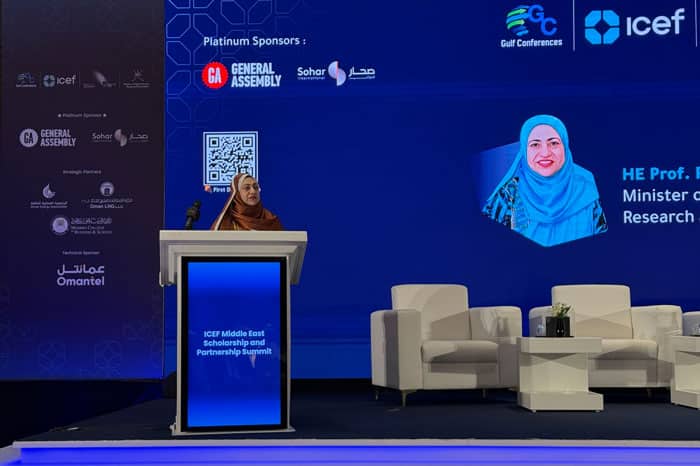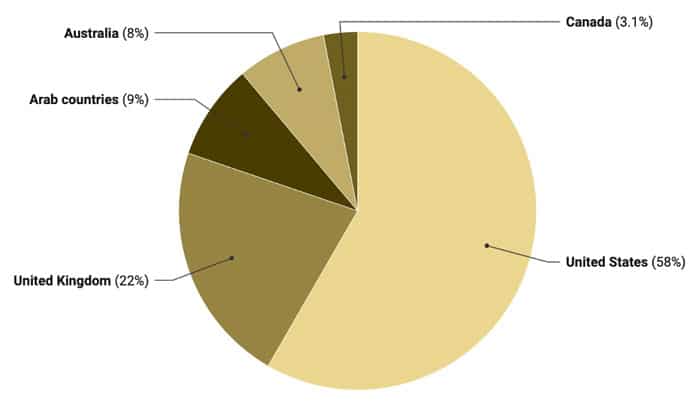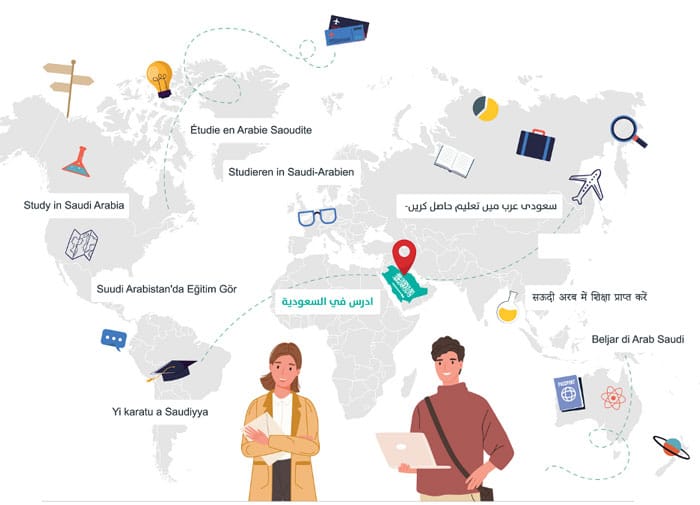Student mobility in MENA boosted by foreign partnerships and branch campuses
- Special economic and administrative zones across the Middle East and North Africa feature a growing number of branch campuses of foreign universities
- Dubai, in particular, is moving fast on its ambition to be a Top 10 Student City and major host of international students
- Saudi Arabia is courting private sector investment and opening up to branch campuses to increase capacity and quality in the Kingdom
- Egypt just accepted another foreign partnership to be hosted at Ain Shams University International Campus – this time with the Russell Group’s University of Exeter (January 2025)
As Western countries tighten their rules around international student recruitment, Middle Eastern nations are increasing infrastructure and investment to attract more foreign students than ever. Branch campuses and other transnational education agreements are a big part of this development.
Speaking at the ICEF Middle East Scholarship and Partnership Summit in Muscat this week, Oman’s Minister of Higher Education, Research, and Innovation HE Prof Rahma bint Ibrahim Al Mahrooqi welcomed delegates from around the Gulf region and abroad, saying: “It is without a doubt that your participation and informative presentations will greatly contribute to the success of this knowledge dialogue as we expand the horizon of shared knowledge and best practices in the fields of student and academic exchange.”
Dr Al Mahrooqi added that the summit was “supporting the country's transformation to a knowledge-based economy, and the realisation of many other objectives of Oman’s Vision 2040. In addition, the Ministry is working on twinning Oman's higher education institutions with the high-ranked international universities like those attending and participating in this summit today.”

The Minister went on to explain that her officials are increasingly focused on opportunities in postgraduate study and research in areas identified as top priorities in Oman’s Vision 2040 strategy. These include energy, environmental science, logistics, fisheries, agriculture, and a range of technology fields. “Hence,” she added, “this ministry has focused more on sponsoring students in specialisations related to these fields, as well as specialisations that thrived as a result of the fourth industrial revolution, like artificial intelligence, the Internet of things, data management, quantum computing, and cybersecurity.”
Omani officials indicated separately that there are now more than 5,000 foreign students enrolled in the country, and that the Sultanate is actively working to link policy development around international students to the internationalisation efforts of Omani universities and the government’s larger goals to internationalise its higher education system.
Dubai plans to double international student numbers
Meanwhile, Dubai is setting the pace in the region in the race to draw more international students. For example, Dubai – one of seven emirates in the United Arab Emirates (UAE) – announced an Education 33 (E33) strategy in November 2024 that includes a goal of increasing international students in its higher education system by 50% by 2033. Other related goals are to see:
- Educational tourism ramp up to 10 times the current level;
- Dubai ranked in the Top 10 Student Cities (it is currently 72nd);
- Three Dubai universities rank in the Top 100 QS university rankings.
Recently, growth in international student numbers has been very rapid: the number of international students in Dubai (including students coming to Dubai for the purpose of study and first- or second-generation foreign residents in the UAE) has increased by 25% since the 2022/23 academic year.
The following screenshot, shared by Dubai’s Knowledge and Human Development Authority (KDHA), shows some of the latest developments in Dubai’s educational expansion.

Much of this new activity is happening in the economic “freezones” of Dubai’s Knowledge Village (DKV) and Dubai International Academic City (DIAC). These zones are owned by a for-profit branch of the Dubai government (TECOM Group). TECOM provides “ready-to-lease buildings and other services that allow institutions to quickly start operations.”
More branch campuses in the works
A spokesperson from KDHA told delegates at a conference hosted by Middlesex University Dubai in January 2025 that the expectation is for international enrolments to double by 2040, and that this will require even more branch campus expansion beyond the roughly 30 already in operation. Up to 15 additional branch campuses are anticipated to meet demand.
Already, there are close to 60 “international” campuses in Dubai, most of which are branch campuses in designated zones. The screenshot below shows the top home country origins of campuses in the emirate, and as you can see, Dubai welcomes both Western and non-Western partners. At least a third of branch campuses are from India, Lebanon, Russia, Pakistan, and Iran, and these campuses enrol a higher share of students from the local expatriate community than Western ones.

Almost 9 in 10 residents in the UAE have roots in other countries and can be first-generation, second-generation, or third-generation expatriates. They do not have citizenship but do have many other rights as residents in the UAE. The many countries represented by the expat community is part of the reason for the diversity of education options in the UAE and for the large number of branch campuses from all over the world.
After the UK, India has the most branch campuses in Dubai. Indians make up almost 40% of the total population of the UAE and number about 3.5 million across the seven emirates.
Indians represent the largest sending country
Across the UAE, international enrolments stand at about 220,000 – including (1) those coming from other countries specifically to study and (2) expatriates that are already living and working in the Emirates.
Of those coming from other countries to Dubai for studies, most are from India (43%), Russia (5%), Pakistan (5%), and Saudi Arabia (3%). More than half of them study business (55%), with engineering and IT next (11% and 9%, respectively). Half are in undergraduate programmes (51%), and 39% are at the master’s level.
What students say about Dubai
Dubai is increasingly developing a reputation for being an exciting student city – and for unique reasons. Jill Ahrens, for her 2024 research project, “Place and mobility trajectories: domestic students and international students in the education hub of Dubai,” interviewed international students in Dubai and noted:
“Students, who lived in another Arab or Muslim-majority country prior to coming to Dubai, commented upon the lifestyle in the city, which permits its residents to follow moderate Muslim principles, while at the same time offering ample opportunities for entertainment. In this sense, Dubai is exceptional amongst the other GCC countries and even the other UAE emirates...Dubai occupies a curious ‘in-between’ space, located west of the ‘East’ and east of the ‘West’.”
One postgraduate student at a British branch campus, said:
“It was more comfortable for me to come here rather than shifting all the way to Canada and getting used to the whole new environment. So I think it was in my comfortable zone, so I agreed to it. Because usually things work out in the same way here or Saudi Arabia or take any country in the GCC, they all have the same rules and regulations that they follow, so I think that was the reason why I came to Dubai.”
Saudi Arabia is trailing Dubai in international student growth
In 2016, Saudi Arabia sent over 100,000 students abroad for studies, mostly to the West. Many students were funded by the massive King Abdullah Scholarship Program (KASP), which has since been replaced by smaller, more targeted scholarships. The winding down of KASP contributed to a significant decline in outbound student mobility from Saudi Arabia, and in 2022, only around 50,000 Saudis were studying abroad.

As outbound declined, however, the Saudi government set its sights on becoming a regional education hub and top tourism destination, goals that support its need to diversify the economy beyond oil and gas and that are articulated in its Vision 2030 project.
Inbound student numbers grew to over 74,000 international students in 2017, but this has since fallen to just over 64,000, according to UNESCO data (2022). There was a nearly 17% decline between 2017–21, but a slight uptick in 2022. Two elements in the story of the decrease in international student numbers is:
- The UAE moving more quickly than Saudi Arabia to welcome branch campuses, and Dubai, in particular, dramatically increasing its attractiveness and ability to host international students in the span of a couple of years;
- Increased demand from Saudi students to remain at home for higher education, leading to capacity issues.
Branch campus activity is strengthening in Saudi Arabia, however, and it dovetails with an increasing emphasis on private sector funding and institutions in higher education provision in the Kingdom. The government wants the private sector to meet (1) burgeoning local demand for education (900,000 additional places need to be created by 2030, a 42% increase over the 2 million currently provided mostly by the state), and (2) regional demand for quality education.
University World News reported in September 2024 that:
“The Saudi Arabian government has awarded foreign investor licences to five international public and private universities, opening the way for them to set up branch campuses in the kingdom offering masters and bachelor programmes in priority areas such as healthcare, engineering, and business.”
The licences are for the following universities, though University World News noted that details and final approvals are pending/opaque in some cases:
- Arizona State University (US)
- University of Wollongong (Australia)
- University of Stratheclyde (Scotland)
- The Royal College of Surgeons in Ireland
- IE University (Spain)
Increased investment in attracting investment and in international student recruitment
Oher signals of Saudi Arabia’s goal to compete more vigorously as an education hub in the region include:
- The Invest Saudi platform, which includes an invitation for foreign companies to help the Kingdom reach “human capital and innovation goals.”
- The Study in Saudi Arabia platform, where international undergraduate and graduate students can apply for scholarships.
- Streamlined visa processing;
- More cooperation with US universities including “joint research initiatives, student and faculty exchange programs, the development of new academic programs, and industry-academia partnerships.”

The new push for private sector involvement may see Saudi Arabia join UAE, Egypt, and Oman in a much greater push to attract international students.
Egyptian universities hosted 26,000 international students in the academic year 2023/24 – a 117% increase over 2019/20, according to Minister of Higher Education Ayman Ashour. Growth markets include Syria, Saudi Arabia, Yemen, Oman, India, and Nigeria, and new priority countries are China, Malaysia, Iraq, Qatar, and Bahrain.
Egypt’s new Administrative Capital features branch campuses and dual degree partnerships including foreign institutions such as:
- The University of Prince Edward Island (Canada)
- Toronto Metropolitan University (Canada);
- Coventry University (UK);
- University of Hertfordshire (UK);
- University of London
- British University of Central Lancashire
- University of Exeter (UK)
- Nova University Lisbon (Portugal)
Egypt also has plans to establish Egyptian branch campuses across Africa and Asia.
For additional background, please see:
















